sensor RENAULT MEGANE RS 2012 X95 / 3.G Owners Manual
[x] Cancel search | Manufacturer: RENAULT, Model Year: 2012, Model line: MEGANE RS, Model: RENAULT MEGANE RS 2012 X95 / 3.GPages: 239, PDF Size: 9.2 MB
Page 32 of 239
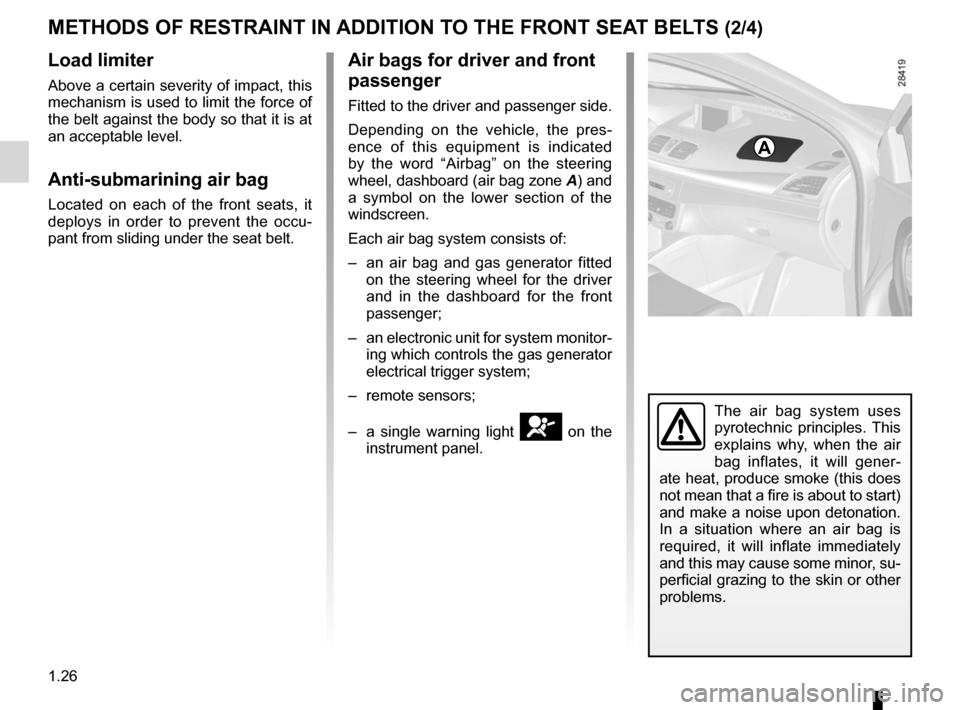
1.26
ENG_UD18889_4
Dispositifs complémentaires aux ceintures avant (X95 - B95 - D95 - R\
enault)
ENG_NU_837-6_BDK95_Renault_1
Jaune NoirNoir texte
mETHOds Of REsTRAINT IN AddITION TO THE fRONT sEAT BELTs (2/4)
Load limiter
Above a certain severity of impact, this
mechanism is used to limit the force of
the belt against the body so that it is at
an acceptable level.
Anti-submarining air bag
Located on each of the front seats, it
deploys in order to prevent the occu -
pant from sliding under the seat belt.
Air bags for driver and front
passenger
Fitted to the driver and passenger side.
Depending on the vehicle, the pres -
ence of this equipment is indicated
by the word “Airbag” on the steering
wheel, dashboard (air bag zone A) and
a symbol on the lower section of the
windscreen.
Each air bag system consists of:
– an air bag and gas generator fitted
on the steering wheel for the driver
and in the dashboard for the front
passenger;
– an electronic unit for system monitor-
ing which controls the gas generator
electrical trigger system;
– remote sensors;
– a single warning light
å on the
instrument panel.
A
The air bag system uses
pyrotechnic principles. This
explains why, when the air
bag inflates, it will gener -
ate heat, produce smoke (this does
not mean that a fire is about to start)
and make a noise upon detonation.
In a situation where an air bag is
required, it will inflate immediately
and this may cause some minor, su-
perficial grazing to the skin or other
problems.
Page 70 of 239
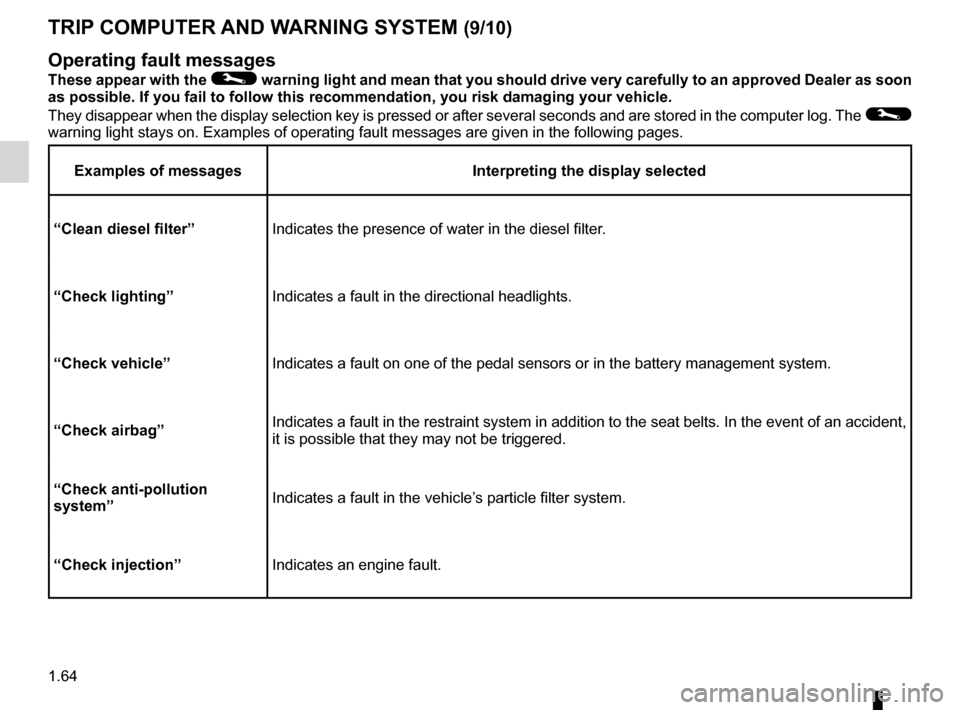
1.64
ENG_UD18879_3
Ordinateur de bord (X95 - B95 - D95 - Renault)
ENG_NU_837-6_BDK95_Renault_1
Jaune NoirNoir texte
TRIp cOmpUTER ANd WARNINg sYsTEm (9/10)
Operating fault messages
These appear with the © warning light and mean that you should drive very carefully to an approved dealer as soon
as possible. If you fail to follow this recommendation, you risk damagin\
g your vehicle.
They disappear when the display selection key is pressed or after several seconds and are stored in the computer log. The
©
warning light stays on. Examples of operating fault messages are given i\
n the following pages.
Examples of messages Interpreting the display selected
“clean diesel filter” Indicates the presence of water in the diesel filter.
“check lighting ”Indicates a fault in the directional headlights.
“check vehicle” Indicates a fault on one of the pedal sensors or in the battery manageme\
nt system.
“check airbag” Indicates a fault in the restraint system in addition to the seat belts. In the event of an accident,
it is possible that they may not be triggered.
“check anti-pollution
system ” Indicates a fault in the vehicle’s particle filter system.
“check injection” Indicates an engine fault.
Page 72 of 239
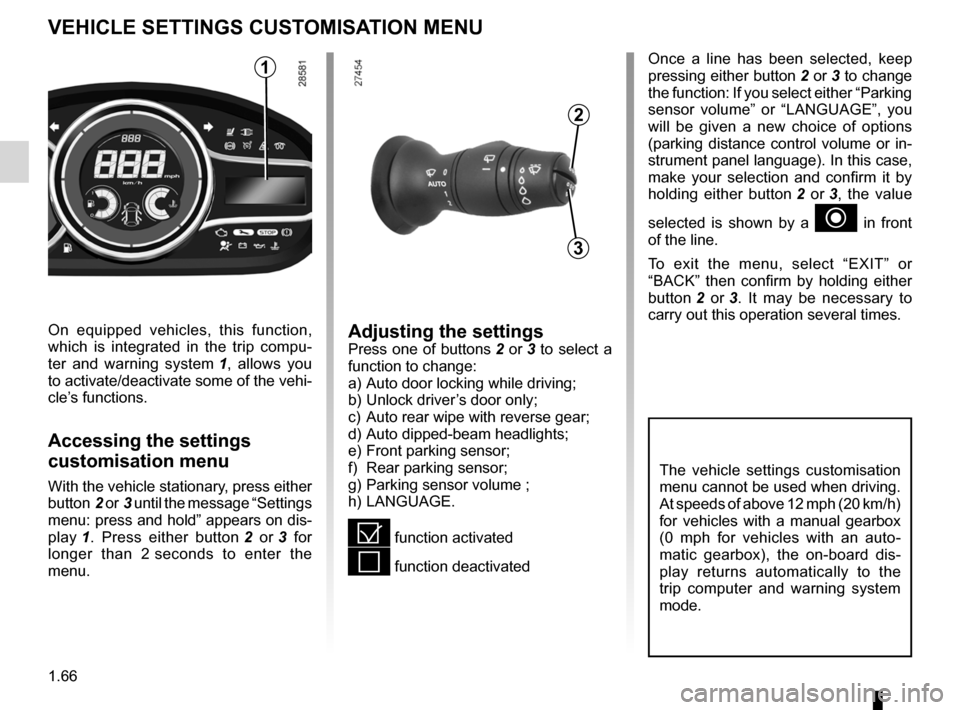
menu for customising the vehicle settings
(up to the end of the DU)
customising the vehicle settings ........... (up to the end of the DU)
customised vehicle settings .................. (up to the end of the DU)
1.66
ENG_UD11347_2
Menu de personnalisation des réglages du véhicule (X95 - B95 - D9\
5 - Renault)
ENG_NU_837-6_BDK95_Renault_1
vehicle settings customisation menu
vEHIcLE sETTINgs cUsTOmIsATION mENU
Adjusting the settingsPress one of buttons 2 or 3 to select a
function to change:
a) Auto door locking while driving ;
b) Unlock driver’s door only ;
c) Auto rear wipe with reverse gear ;
d) Auto dipped-beam headlights ;
e) Front parking sensor ;
f) Rear parking sensor ;
g) Parking sensor volume ;
h) LANGUAGE.
= function activated
< function deactivated
On equipped vehicles, this function,
which is integrated in the trip compu
-
ter and warning system 1 , allows you
to activate/deactivate some of the vehi-
cle’s functions.
Accessing the settings
customisation menu
With the vehicle stationary, press either
button 2 or 3 until the message “Settings
menu: press and hold ” appears on dis-
play 1 . Press either button 2 or 3 for
longer than 2 seconds to enter the
menu.
Once a line has been selected, keep
pressing either button 2 or 3 to change
the function: If you select either “Parking
sensor volume ” or “LANGUAGE ”, you
will be given a new choice of options
(parking distance control volume or in-
strument panel language). In this case,
make your selection and confirm it by
holding either button 2 or 3 , the value
selected is shown by a
~ in front
of the line.
To exit the menu, select “ EXIT” or
“ BACK ” then confirm by holding either
button 2 or 3 . It may be necessary to
carry out this operation several times.
2
3
1
The vehicle settings customisation
menu cannot be used when driving.
At speeds of above 12 mph (20 km/h)
for vehicles with a manual gearbox
(0 mph for vehicles with an auto -
matic gearbox), the on-board dis -
play returns automatically to the
trip computer and warning system
mode.
Page 81 of 239
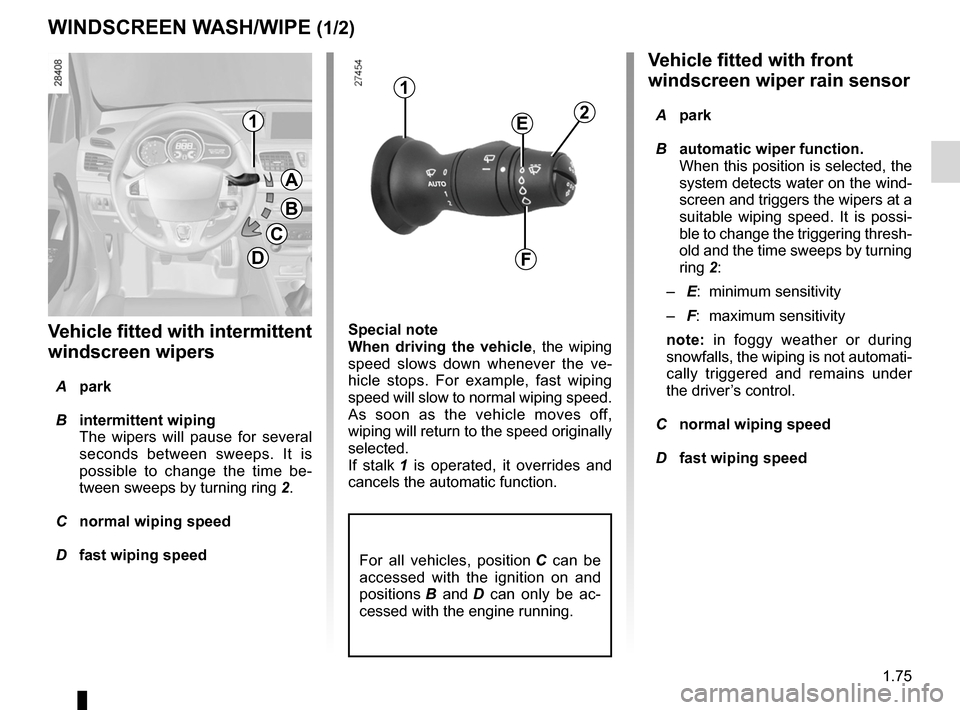
wipers ................................................... (up to the end of the DU)
windscreen washer/wiper ..................... (up to the end of the DU)
windscreen washer ............................... (up to the end of the DU)
1.75
ENG_UD17355_4
Essuie-vitre / lave-vitre avant (X95 - B95 - D95 - Renault)
ENG_NU_837-6_BDK95_Renault_1
Wash/Wipe
v ehicle fitted with front
windscreen wiper rain sensor
A park
B automatic wiper function.
When this position is selected, the
system detects water on the wind -
screen and triggers the wipers at a
suitable wiping speed. It is possi -
ble to change the triggering thresh-
old and the time sweeps by turning
ring 2:
– E: minimum sensitivity
– F: maximum sensitivity
note: in foggy weather or during
snowfalls, the wiping is not automati-
cally triggered and remains under
the driver’s control.
C normal wiping speed
D fast wiping speed
special note
When driving the vehicle
, the wiping
speed slows down whenever the ve -
hicle stops. For example, fast wiping
speed will slow to normal wiping speed.
As soon as the vehicle moves off,
wiping will return to the speed originally
selected.
If stalk 1 is operated, it overrides and
cancels the automatic function.
v ehicle fitted with intermittent
windscreen wipers
A park
B intermittent wiping
The wipers will pause for several
seconds between sweeps. It is
possible to change the time be -
tween sweeps by turning ring 2.
C normal wiping speed
D fast wiping speed
WINdscREEN WAsH/WIpE (1/2)
1
1
A
B
c
d
E
f
2
For all vehicles, position C can be
accessed with the ignition on and
positions B and D can only be ac -
cessed with the engine running.
Page 101 of 239
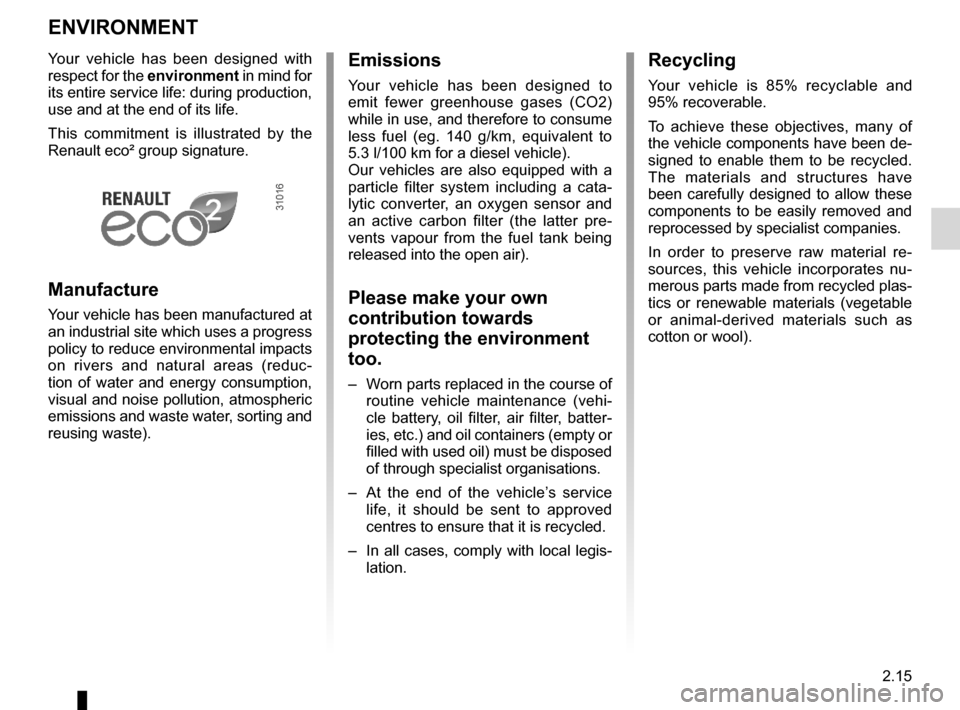
environment .......................................... (up to the end of the DU)
2.15
ENG_UD16012_2
Environnement (X95 - E95 - E33 - X33 - X62 - Renault)
ENG_NU_837-6_BDK95_Renault_2
Environment
ENVIRONMENT
Emissions
Your vehicle has been designed to
emit fewer greenhouse gases (CO2)
while in use, and therefore to consume
less fuel (eg. 140 g/km, equivalent to
5.3 l/100 km for a diesel vehicle).
Our vehicles are also equipped with a
particle filter system including a cata -
lytic converter, an oxygen sensor and
an active carbon filter (the latter pre -
vents vapour from the fuel tank being
released into the open air).
Please make your own
contribution towards
protecting the environment
too.
– Worn parts replaced in the course of
routine vehicle maintenance (vehi -
cle battery, oil filter, air filter, batter -
ies, etc.) and oil containers (empty or
filled with used oil) must be disposed
of through specialist organisations.
– At the end of the vehicle’s service
life, it should be sent to approved
centres to ensure that it is recycled.
– In all cases, comply with local legis -
lation.
Recycling
Your vehicle is 85% recyclable and
95% recoverable.
To achieve these objectives, many of
the vehicle components have been de-
signed to enable them to be recycled.
The materials and structures have
been carefully designed to allow these
components to be easily removed and
reprocessed by specialist companies.
In order to preserve raw material re -
sources, this vehicle incorporates nu -
merous parts made from recycled plas-
tics or renewable materials (vegetable
or animal-derived materials such as
cotton or wool).
Your vehicle has been designed with
respect for the
environment in mind for
its entire service life: during production,
use and at the end of its life.
This commitment is illustrated by the
Renault eco² group signature.
Manufacture
Your vehicle has been manufactured at
an industrial site which uses a progress
policy to reduce environmental impacts
on rivers and natural areas (reduc -
tion of water and energy consumption,
visual and noise pollution, atmospheric
emissions and waste water, sorting and
reusing waste).
Page 102 of 239
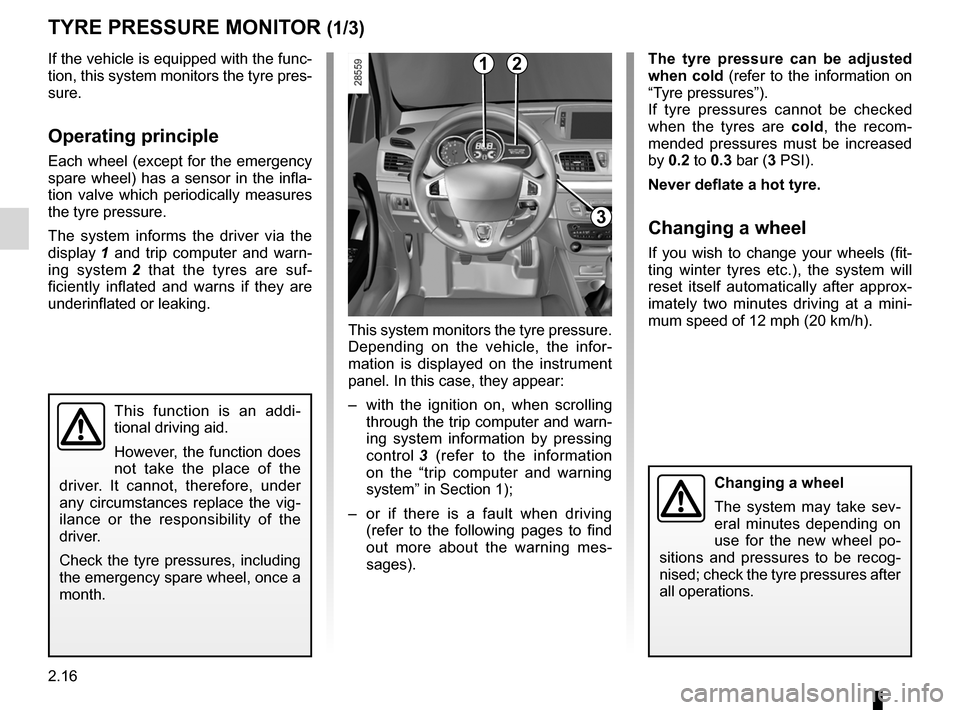
tyres ...................................................... (up to the end of the DU)
tyre pressure monitor ............................(up to the end of the DU)
tyre pressure ......................................... (up to the end of the DU)
driving ................................................... (up to the end of the DU)
2.16
ENG_UD6303_1
Système de surveillance de pression des pneumatiques (X95 - B95 - D9\
5 - Renault)
ENG_NU_837-6_BDK95_Renault_2
Jaune NoirNoir texte
This system monitors the tyre pressure.
Depending on the vehicle, the infor -
mation is displayed on the instrument
panel. In this case, they appear:
– with the ignition on, when scrolling
through the trip computer and warn-
ing system information by pressing
control 3 (refer to the information
on the “trip computer and warning
system” in Section 1);
– or if there is a fault when driving
(refer to the following pages to find
out more about the warning mes -
sages).
Tyre pressure monitor
This function is an addi -
tional driving aid.
However, the function does
not take the place of the
driver. It cannot, therefore, under
any circumstances replace the vig -
ilance or the responsibility of the
driver.
Check the tyre pressures, including
the emergency spare wheel, once a
month.
TyRE PRESSURE MONITOR (1/3)
If the vehicle is equipped with the func-
tion, this system monitors the tyre pres-
sure.
Operating principle
Each wheel (except for the emergency
spare wheel) has a sensor in the infla-
tion valve which periodically measures
the tyre pressure.
The system informs the driver via the
display 1 and trip computer and warn -
ing system 2 that the tyres are suf -
ficiently inflated and warns if they are
underinflated or leaking.
The tyre pressure can be adjusted
when cold (refer to the information on
“Tyre pressures”).
If tyre pressures cannot be checked
when the tyres are cold, the recom -
mended pressures must be increased
by 0.2 to 0.3 bar (3 PSI).
Never deflate a hot tyre.
Changing a wheel
If you wish to change your wheels (fit-
ting winter tyres etc.), the system will
reset itself automatically after approx -
imately two minutes driving at a mini -
mum speed of 12 mph (20 km/h).
12
Changing a wheel
The system may take sev -
eral minutes depending on
use for the new wheel po -
sitions and pressures to be recog -
nised; check the tyre pressures after
all operations.
3
Page 103 of 239
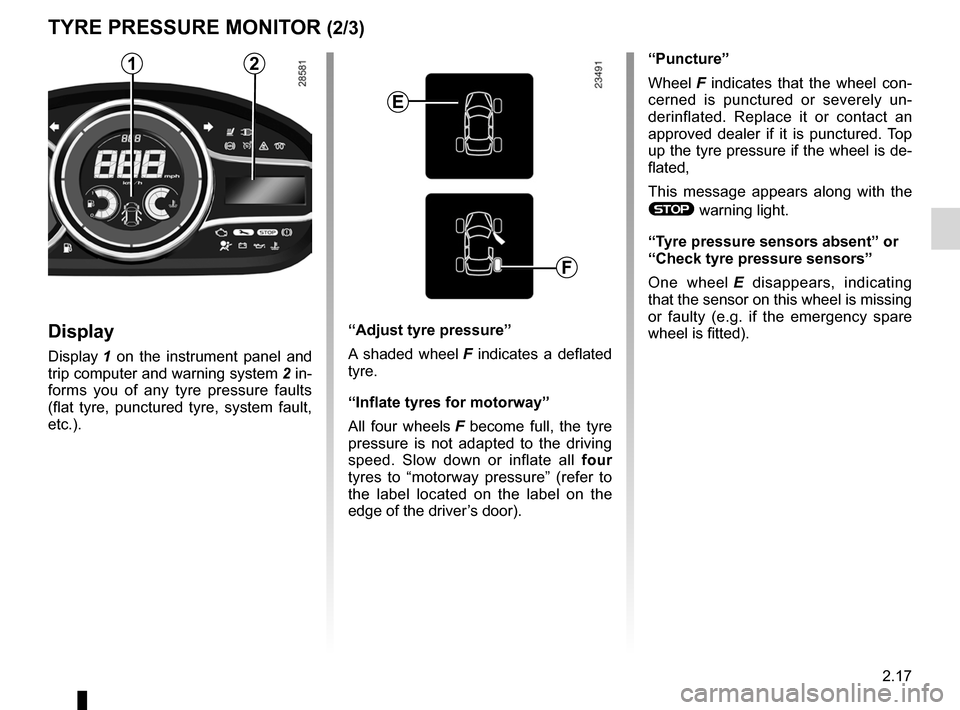
JauneNoirNoir texte
2.17
ENG_UD6303_1
Système de surveillance de pression des pneumatiques (X95 - B95 - D9\
5 - Renault)
ENG_NU_837-6_BDK95_Renault_2
Display
Display 1 on the instrument panel and
trip computer and warning system 2 in-
forms you of any tyre pressure faults
(flat tyre, punctured tyre, system fault,
etc.).
TyRE PRESSURE MONITOR (2/3)
1“Puncture”
Wheel F indicates that the wheel con -
cerned is punctured or severely un -
derinflated. Replace it or contact an
approved dealer if it is punctured. Top
up the tyre pressure if the wheel is de-
flated,
This message appears along with the
® warning light.
“Tyre pressure sensors absent ” or
“Check tyre pressure sensors ”
One wheel E disappears, indicating
that the sensor on this wheel is missing
or faulty (e.g. if the emergency spare
wheel is fitted).
“Adjust tyre pressure
”
A shaded wheel F indicates a deflated
tyre.
“Inflate tyres for motorway”
All four wheels F become full, the tyre
pressure is not adapted to the driving
speed. Slow down or inflate all four
tyres to “motorway pressure” (refer to
the label located on the label on the
edge of the driver’s door).
E
F
2
Page 104 of 239
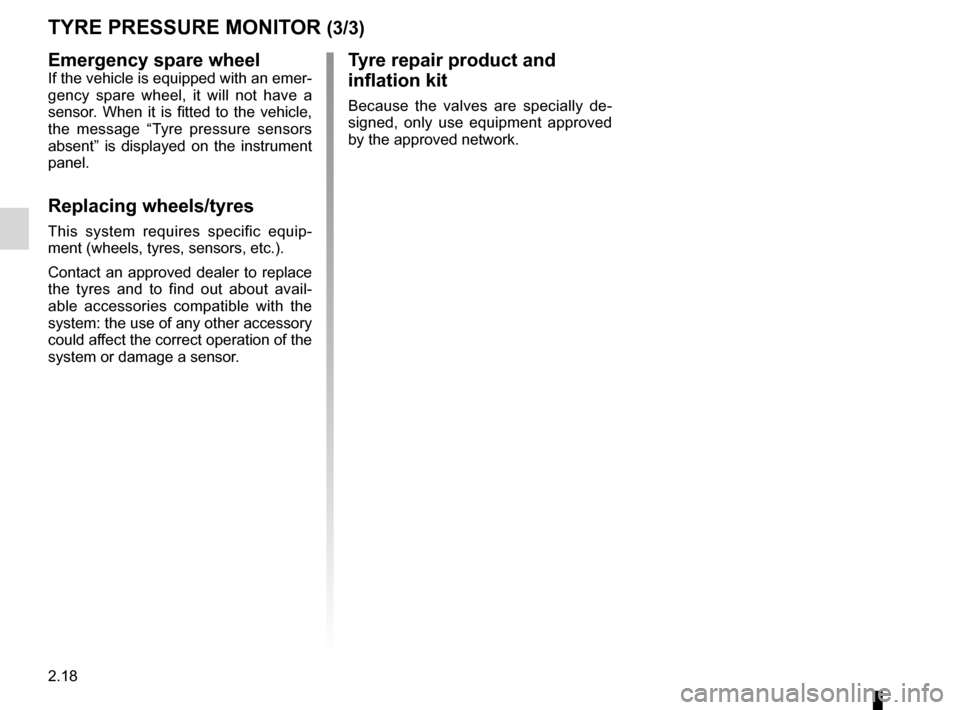
2.18
ENG_UD6303_1
Système de surveillance de pression des pneumatiques (X95 - B95 - D9\
5 - Renault)
ENG_NU_837-6_BDK95_Renault_2
Tyre repair product and
inflation kit
Because the valves are specially de -
signed, only use equipment approved
by the approved network.
TyRE PRESSURE MONITOR (3/3)
Emergency spare wheel
If the vehicle is equipped with an emer-
gency spare wheel, it will not have a
sensor. When it is fitted to the vehicle,
the message “ Tyre pressure sensors
absent” is displayed on the instrument
panel.
Replacing wheels/tyres
This system requires specific equip -
ment (wheels, tyres, sensors, etc.).
Contact an approved dealer to replace
the tyres and to find out about avail -
able accessories compatible with the
system: the use of any other accessory
could affect the correct operation of the
system or damage a sensor.
Page 106 of 239
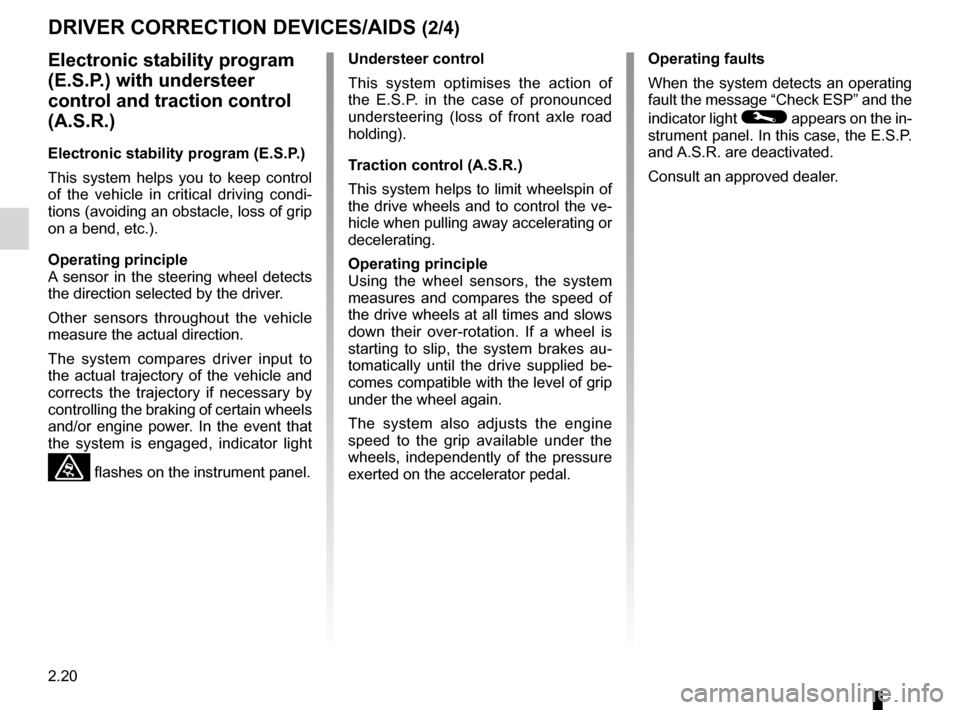
2.20
ENG_UD14885_2
Dispositifs de correction de conduite (X95 - B95 - D95 - Renault)
ENG_NU_837-6_BDK95_Renault_2
Jaune NoirNoir texte
DRIVER CORRECTION DEVICES/AIDS (2/4)
Electronic stability program
(E.S.P.) with understeer
control and traction control
(A.S.R.)
Electronic stability program (E.S.P.)
This system helps you to keep control
of the vehicle in critical driving condi -
tions (avoiding an obstacle, loss of grip
on a bend, etc.).
Operating principle
A sensor in the steering wheel detects
the direction selected by the driver.
Other sensors throughout the vehicle
measure the actual direction.
The system compares driver input to
the actual trajectory of the vehicle and
corrects the trajectory if necessary by
controlling the braking of certain wheels
and/or engine power. In the event that
the system is engaged, indicator light
ù flashes on the instrument panel. Understeer control
This system optimises the action of
the E.S.P. in the case of pronounced
understeering (loss of front axle road
holding).
Traction control (A.S.R.)
This system helps to limit wheelspin of
the drive wheels and to control the ve-
hicle when pulling away accelerating or
decelerating.
Operating principle
Using the wheel sensors, the system
measures and compares the speed of
the drive wheels at all times and slows
down their over-rotation. If a wheel is
starting to slip, the system brakes au
-
tomatically until the drive supplied be -
comes compatible with the level of grip
under the wheel again.
The system also adjusts the engine
speed to the grip available under the
wheels, independently of the pressure
exerted on the accelerator pedal. Operating faults
When the system detects an operating
fault the message “Check ESP” and the
indicator light
© appears on the in-
strument panel. In this case, the E.S.P.
and A.S.R. are deactivated.
Consult an approved dealer.
Page 116 of 239
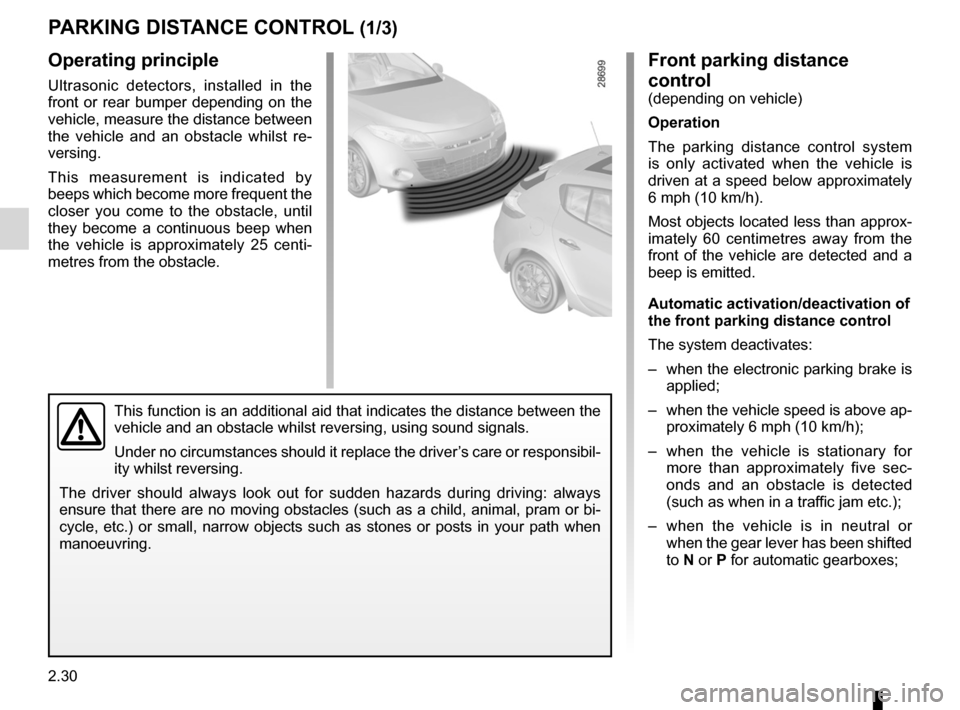
parking distance control........................(up to the end of the DU)
driving ................................................... (up to the end of the DU)
reversing sensor ................................... (up to the end of the DU)
2.30
ENG_UD14786_3
Aide au parking (X95 - B95 - D95 - Renault)
ENG_NU_837-6_BDK95_Renault_2
Jaune NoirNoir texte
Parking distance control
This function is an additional aid that indicates the distance between the
vehicle and an obstacle whilst reversing, using sound signals.
Under no circumstances should it replace the driver’s care or responsibil -
ity whilst reversing.
The driver should always look out for sudden hazards during driving: always
ensure that there are no moving obstacles (such as a child, animal, pram or bi-
cycle, etc.) or small, narrow objects such as stones or posts in your path when
manoeuvring.
Operating principle
Ultrasonic detectors, installed in the
front or rear bumper depending on the
vehicle, measure the distance between
the vehicle and an obstacle whilst re -
versing.
This measurement is indicated by
beeps which become more frequent the
closer you come to the obstacle, until
they become a continuous beep when
the vehicle is approximately 25 centi -
metres from the obstacle.
PARkING DISTANCE CONTROL (1/3)
Front parking distance
control
(depending on vehicle)
Operation
The parking distance control system
is only activated when the vehicle is
driven at a speed below approximately
6 mph (10 km/h).
Most objects located less than approx -
imately 60 centimetres away from the
front of the vehicle are detected and a
beep is emitted.
Automatic activation/deactivation of
the front parking distance control
The system deactivates:
– when the electronic parking brake is
applied;
– when the vehicle speed is above ap-
proximately 6 mph (10 km/h);
– when the vehicle is stationary for
more than approximately five sec -
onds and an obstacle is detected
(such as when in a traffic jam etc.);
– when the vehicle is in neutral or
when the gear lever has been shifted
to N or P for automatic gearboxes;